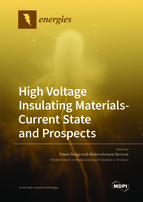High Voltage Insulating Materials-Current State and Prospects
A special issue of Energies (ISSN 1996-1073). This special issue belongs to the section "D1: Advanced Energy Materials".
Deadline for manuscript submissions: closed (31 January 2021) | Viewed by 35321
Special Issue Editors
Interests: high-voltage engineering; pre-breakdown and breakdown phenomena in dielectric liquids; alternative dielectric liquids for electrical purposes; statistics in electrical engineering; partial discharges; insulation of power transformers
Special Issues, Collections and Topics in MDPI journals
Interests: high voltage engineering; insulation coordination; outdoor insulation; dielectric materials (gases, liquids, nanofluids, interfaces); long air gaps discharge and lightning; modelling of discharges and composite materials
Special Issues, Collections and Topics in MDPI journals
Special Issue Information
Dear Colleagues,
The proper operation of high-voltage devices, especially transformers, is mainly determined by their insulation conditions. Solid, liquid, and gaseous dielectrics used as electrical insulation in high-voltage equipment must ensure correct, continuous, uninterrupted, and safe operation of the devices. In addition, ensuring an appropriate level of environmental safety is extremely important. Insulation materials work under conditions of high temperature, high electric fields, or mechanical stresses. Such conditions require high-quality materials, which should not change over time. Therefore, it is very important to study the properties of materials used in high-voltage equipment from various perspectives, such as electrical (AC, DC, LI, or combined exposure), thermal (e.g., accelerated aging), or chemical (impact of environmental factors or material compatibility). In all these areas, researchers are seeking to find optimal solutions for insualting materials that will work well in industrial applications. The development of the HVDC technology, which involves specific stress conditions and thus specific physical phenomena associated with stress, has become extremely important in this respect.
Since insulating materials are constantly developing and new materials keep appearing in the market (e.g., biodegradable insulating liquids in the case of liquid dielectrics or nano-fluids), this Special Issue will be focused on all aspects of new solutions proposed for use in high-voltage applications.
Therefore, papers that deal with the study of the dielectric and thermal properties of insulation materials for electrical applications and those focused on other properties of dielectrics are warmly welcomed. Studies on the chemical structure of materials and on the impact of this structure (admixtures, nanoparticles) on the properties of single dielectrics and mixtures are also of interest. Papers may as well report research methods to study insulating materials in the laboratory testing phase as well as in operating conditions.
Prof. Dr. Pawel Rozga
Prof. Dr. Abderrahmane Beroual
Guest Editors
Manuscript Submission Information
Manuscripts should be submitted online at www.mdpi.com by registering and logging in to this website. Once you are registered, click here to go to the submission form. Manuscripts can be submitted until the deadline. All submissions that pass pre-check are peer-reviewed. Accepted papers will be published continuously in the journal (as soon as accepted) and will be listed together on the special issue website. Research articles, review articles as well as short communications are invited. For planned papers, a title and short abstract (about 100 words) can be sent to the Editorial Office for announcement on this website.
Submitted manuscripts should not have been published previously, nor be under consideration for publication elsewhere (except conference proceedings papers). All manuscripts are thoroughly refereed through a single-blind peer-review process. A guide for authors and other relevant information for submission of manuscripts is available on the Instructions for Authors page. Energies is an international peer-reviewed open access semimonthly journal published by MDPI.
Please visit the Instructions for Authors page before submitting a manuscript. The Article Processing Charge (APC) for publication in this open access journal is 2600 CHF (Swiss Francs). Submitted papers should be well formatted and use good English. Authors may use MDPI's English editing service prior to publication or during author revisions.
Keywords
- New solutions within solid, liquid, and gaseous dielectrics
- Testing of dielectric materials under AC, DC, and LI voltages
- HV equipment isolation systems (power transformers, transmission lines, substations, switchgears etc.)
- Pre-breakdown and breakdown phenomena in dielectrics
- Aging tests
- Measurement techniques
- Characterization methods and techniques







